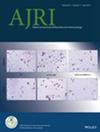Identification of Immunophenotypes as a Mediator of Gut Microbiota-Driven Female Anovulation-Induced Infertility: A Mediation Mendelian Randomization Study
Abstract
Background
The mediatory roles of immune cells in the gut microbiota and anovulation-induced infertility remain unclear. This study aimed to investigate the correlations among gut microbiota, immunophenotypes, and anovulation-induced female infertility using a mediation Mendelian randomization (MR) study.
Methods
An MR design investigates the causal links among gut microbiota (n = 14 306, 195 bacterial taxa), 731 immunophenotypes, and anovulation-induced female infertility (5667 anovulation-induced infertile women and 117 098 controls). The causal effects were evaluated by MR Egger, weighted median, inverse variance weighted (IVW), simple mode method, and weighted mode.
Results
Two phylum members (Cyanobacteria and Bacteroidetes), an order member (Burkholderiales), a family member (Defluviitaleaceae), and seven genus members were causally correlated with the anovulation-induced infertility. Among the seven genera, Subdoligranulum, Clostridium innocuum group, and Escherichia.Shigella were the risk factors, and Prevotella9, Ruminococcus torques group, Eubacterium ventriosum group, and Eubacterium fissicatena group were the protective factors in anovulation-induced infertility. Next, 35 immunophenotypes were identified to be also causally correlated with the anovulation-induced infertility. Among them, 15 immunophenotypes were significantly driven by the seven-microbiota genus and might be the internal mediating mechanism of the influence of gut microbiota on anovulation-induced female infertility. In the mediated MR analysis, four (Clostridium innocuum group, Eubacterium fissicatena group, Eubacterium ventriosum group, and Prevotella9) of the microbiota were directly influenced by six immunophenotypes (T cell, B cell, and dendritic cell panels) and then affected the anovulation-induced infertility.
Conclusion
The mediation MR study provides evidence supporting immunophenotypes as mediators of gut microbiota-influenced female infertility, especially anovulation-induced infertility.

 求助内容:
求助内容: 应助结果提醒方式:
应助结果提醒方式:


